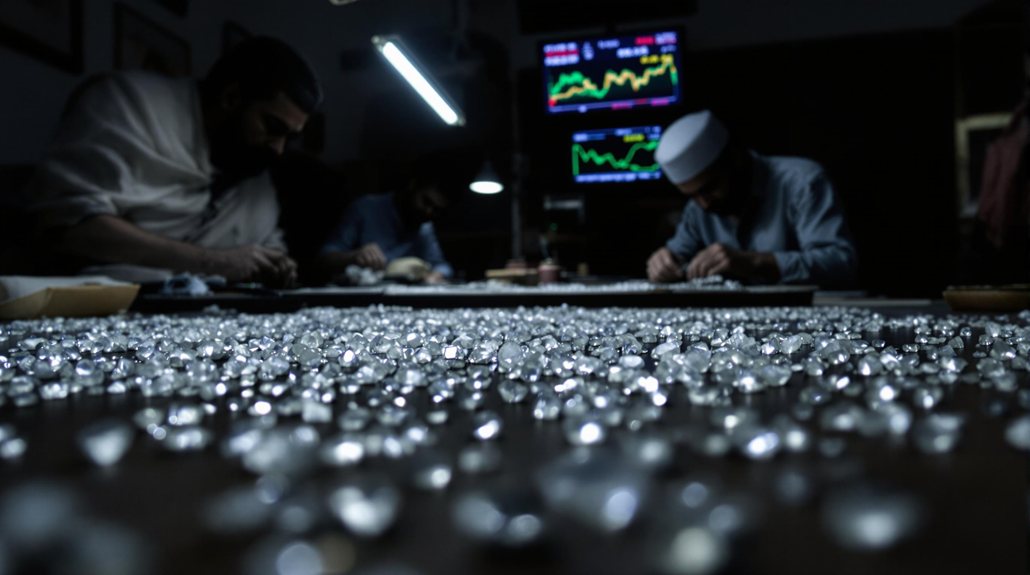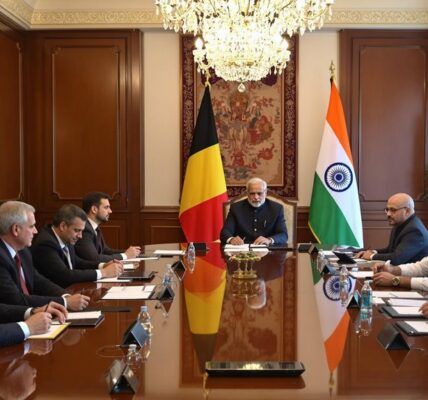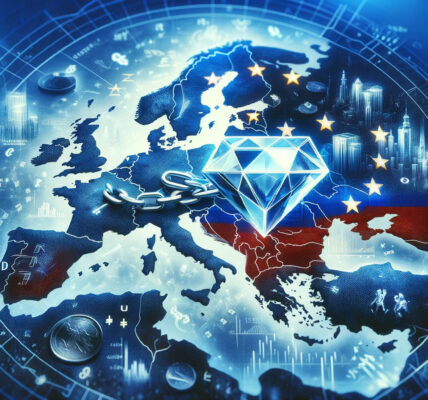India’s £10.6 Billion Diamond Export Industry Faces 18% Contraction Amidst Global Market Pressures
India’s diamond export industry is experiencing a significant downturn, with an anticipated contraction of 18% this year. Initially valued at $15.97 billion, it faces the challenge of global market pressures. Economic uncertainty in key markets like the US and China has reduced luxury spending, including on diamonds. Furthermore, lab-grown diamonds, favoured for affordability and sustainability, are reshaping consumer preferences. Rising operational costs and unsold inventory burdens further strain the industry. Despite obstacles, India’s diamond sector holds historical significance, with promising signs of potential stabilisation, as indicated by recent export growth. Exploring more reveals insights into strategic adaptation and future resilience.
Article Contents
- 1 Article Highlights
- 2 Current Status of India’s Diamond Exports
- 3 Factors Contributing to Export Contraction
- 4 Global Diamond Market Trends
- 5 Effects on Indian Diamond Merchants
- 6 Key Export Destinations
- 7 Historical Export and Import Data
- 8 Frequently Asked Questions
- 8.1 How Are Indian Diamond Companies Adapting to Increased Lab-Grown Diamond Competition?
- 8.2 What Strategies Are Indian Diamantaires Considering to Diversify Their Export Markets?
- 8.3 How Have Consumer Preferences Shifted in Major Diamond Markets Like the UK and China?
- 8.4 Are There Any Governmental Policies in India to Support the Diamond Export Industry?
- 8.5 What Technological Advancements Are Being Implemented in India’s Diamond Processing Industry?
- 9 Our Concluding Thoughts
Article Highlights
- India’s diamond exports are projected to contract by 18-19% in FY2025, reaching £12.5-13 billion.
- Economic downturns in the US and China are reducing global demand for luxury goods, impacting diamond exports.
- The rise of lab-grown diamonds presents affordable and sustainable alternatives, challenging natural diamond demand.
- High inflation and the G7’s Russian diamond sanctions disrupt supply chains, affecting inventory levels and profitability.
- Effective inventory management is crucial as unsold diamond inventory levels increase, impacting financial stability.
Current Status of India’s Diamond Exports
The current landscape of India’s diamond exports is characterised by a complex interplay of economic challenges and evolving market dynamics. As of FY2024, the export value stands at $15.97 billion, positioning India as the world leader in polished diamond exports, accounting for 75% of the global supply. Historically, India was the sole diamond supplier until the discovery of Brazilian mines, highlighting its longstanding dominance in the global diamond industry. However, projections indicate a contraction of 18-19% in FY2025, with exports expected to decline to $12.5-13 billion. This anticipated decline reflects a broader trend of falling export volumes, which are set to decrease by 13-14%, coupled with softening average realisations by 5-6%. As the industry faces these challenges, the growing popularity of synthetic diamonds presents an additional competitive pressure.
Key market dynamics influencing this downturn include sustained subdued global demand, driven by inflationary pressures in the US and a shift in consumer preferences in China towards more affordable lab-grown diamonds. Geopolitical tensions, particularly restrictions on Russian diamonds, have further dampened demand across Europe, while the economic uncertainty in China has renewed interest in gold.
Despite these challenges, a positive sign emerged in October 2024, with an 11.32% increase in exports compared to the previous year, suggesting potential market stabilisation. As India navigates these global market challenges, maintaining its dominant export position will require strategic adaptation to evolving consumer and economic landscapes.
Factors Contributing to Export Contraction
How has the diamond export industry in India reached a point of contraction, despite its historical dominance? Several factors have contributed to this downturn, particularly affecting market demand and consumer preferences.
Economically, key markets like the US and China face challenges, reducing their appetite for luxury items such as diamonds. Inflation in the US has led to decreased spending on discretionary goods, while China’s economic crisis since 2018, alongside a growing preference for gold jewellery, has further dampened diamond demand.
Additionally, the rise of lab-grown diamonds presents formidable competition, shifting consumer preferences towards these more affordable and ethically appealing alternatives. This shift has impacted the demand for India’s natural diamonds, resulting in a contraction of exports.
On the supply chain front, G7 sanctions on Russian diamonds have posed logistical challenges, disrupting the flow of rough diamonds to Indian companies. This has led to high inventory levels and reduced orders, exacerbating supply issues. Furthermore, Dubai has emerged as a major player, with its share in India’s rough diamond imports increasing from 36.3% to 60.8%, while Belgium’s share has significantly decreased.
Furthermore, operational challenges within the Indian diamond sector, including factory closures and quality control issues, have strained the industry. The result is a weakened credit profile for Indian diamond players, struggling to adapt to these shifting dynamics. The diamond industry, comprising over 7,000 companies involved in cutting, polishing, and exporting diamonds, is crucial to the Indian economy, which makes the contraction even more significant.
Global Diamond Market Trends
As the global diamond market evolves, several key trends are influencing its trajectory, particularly the increasing competition from lab-grown diamonds, which offer more affordable and sustainable alternatives. Economic uncertainty further compounds the situation, affecting consumer spending and market stability. Furthermore, geopolitical challenges, including sanctions and supply disruptions, especially from pivotal regions like Russia, are reshaping the supply landscape and exerting additional pressure on traditional diamond markets. The market is projected to grow from £2.43 billion in 2023 to £2.59 billion in 2024, indicating a steady increase despite these challenges. The rising awareness of the environmental impact of mined diamonds and the cost-effectiveness of lab-grown diamonds compared to natural diamonds are significant contributors to market growth.
Lab-Grown Diamond Competition
Frequently reshaping the dynamics of the global diamond industry, lab-grown diamonds are increasingly perceived as a formidable competitor to natural diamonds. The shift towards lab-grown gems is driven by lab-grown benefits such as affordability and environmental sustainability, appealing to a consumer base that values ethical sourcing.
These factors contribute considerably to market pricing, making lab-grown diamonds an attractive alternative. As the market for these synthetic gems expands, it is projected to reach an impressive $56.94 billion by 2032, growing at a CAGR of 10.78%. The global diamond market, including both natural and lab-grown diamonds, is expected to grow from $2.43B in 2023 to $2.59B in 2024, indicating the robust demand for both types of diamonds in the jewellery sector.
In 2023, the annual production of lab-grown diamonds soared to 8 million carats, with major contributions from China, producing 6 million carats. India’s lab-grown diamond exports also surged, hitting $1. 5 billion, reflecting a global trend favouring sustainable and cost-effective options. The Asia-Pacific region captures over 44. 1% of the global lab-grown diamond market share, showcasing its growing dominance in the industry. Dubai’s diamond trade has also begun to embrace lab-grown diamonds, with several leading jewellers and manufacturers incorporating these sustainable alternatives into their collections. This shift towards lab-grown diamonds is driven by consumer demand for ethically sourced and environmentally friendly diamond options. As the technology for producing lab-grown diamonds continues to advance, it is expected that their market share will continue to grow, posing a significant challenge to the traditionally mined diamond industry.
Over 200 companies worldwide are now involved in their production, underscoring this sector’s rapid growth.
The rise of lab-grown diamonds has led to a contraction in natural diamond exports, particularly a 28% decline in India’s exports for FY2024. This underscores a broader consumer preference shift towards sustainable luxury, reshaping the competitive landscape of the global diamond market.
Economic Uncertainty Impact
What drives the fluctuating demand for diamonds amid today’s economic climate? The answer lies in the intertwined relationship between economic uncertainty and consumer behaviour. As high inflation grips developed economies, luxury spending experiences a notable decline. Diamonds, emblematic of luxury, are particularly affected as consumers pivot towards necessities, leaving non-essential luxury items like diamonds behind. The global economic slowdown, marked by reduced spending in pivotal markets such as the US and China, further exacerbates this trend, leading to a notable decline in diamond prices. Amidst these shifts, the rise of synthetic diamonds adds additional pressure on natural diamond prices. Consumer behaviour continues to evolve, with younger generations opting for experiences over material possessions. This shift is compounded by erratic post-pandemic recovery in China, affecting luxury spending patterns. In the US, inflationary pressures add another layer of restraint on diamond demand. The Asia Pacific region, particularly India, shows signs of growth potential, but current global market volatility impacts profitability. As a result, India’s diamond exports have experienced a 19% contraction in the early months of FY2025, mirroring global trends of subdued demand. Market volatility, driven by fluctuating diamond prices and shifting consumer preferences, underscores the industry’s current challenges. Despite these hurdles, the diamond sector’s history of resilience offers a glimmer of hope for eventual recovery, provided economic conditions stabilise.
Geopolitical Supply Challenges
The global diamond market is currently grappling with significant geopolitical supply challenges, a situation deeply influenced by sanctions and market dynamics. G7 sanctions on Russian diamonds, particularly targeting Alrosa PJSC, have disrupted the supply chain, creating complexities for India’s diamond industry. These restrictions have curtailed diamond imports from Russia, tightening global supply and adding pressure on polished diamond prices. The Indian diamond industry employs approximately 1.3 million people, underscoring the significant economic impact of these disruptions. Amid these challenges, the industry is also facing increased competition from lab-grown diamonds, further impacting traditional supply chains.
As the market navigates these hurdles, ethical sourcing has become a focal point, with companies striving to meet evolving consumer demands for sustainable practices. This change is essential as geopolitical tensions and economic uncertainties continue to shape market dynamics. The industry’s resilience is tested as it aligns with emerging trends and adapts to a shifting global landscape.
| Factor | Impact |
|---|---|
| G7 Sanctions | Disrupted global supply chain |
| Russian Diamond Restrictions | Tightened supply, price pressures |
| Competition from Lab-Grown | Challenges traditional supply chains |
| Ethical Sourcing Focus | Aligning with consumer demands |
| Economic Uncertainties | Affected demand, altering market dynamics
Effects on Indian Diamond Merchants
The Indian diamantaires are grappling with significant operational margin challenges as they contend with rising costs and diminished demand. High inventory levels, exacerbated by declining diamond prices, necessitate strategic inventory management to mitigate financial strain. Amidst these struggles, the unsold diamond inventory has increased from 35% to 45.6%, intensifying the financial burden on the industry. As these businesses navigate an increasingly competitive landscape, particularly with the rise of lab-grown diamonds, efficient resource allocation and groundbreaking market approaches become essential for sustaining profitability. The revenue for natural diamond exporters faces ongoing serious headwinds due to market shifts, highlighting the urgent need for industry players to adapt swiftly to evolving consumer preferences and external economic pressures.
Operational Margin Challenges
Rising operational costs have greatly squeezed the margins of Indian diamantaires, posing substantial challenges to their profitability. As labour expenses rise, along with surging energy costs, these businesses are compelled to rethink their cost management practices to stay afloat. Furthermore, the heightened costs of procuring rough diamonds have further strained their financial resources. These pressures, compounded by inflation and logistical disruptions, necessitate creative pricing strategies to maintain competitiveness in the global market.
Global market pressures exacerbate the situation, with declining diamond prices cutting into profits. The rise of synthetic diamonds has intensified competition, making it vital for diamantaires to adjust their pricing approaches strategically. With the share of unsold diamonds returned to India increasing from 35% to 45.6%, diamantaires face added pressure to manage excess inventory effectively. As India remains a major exporter of cut and polished diamonds, the global demand fluctuations have a direct impact on their operations, highlighting the importance of strategic market positioning.
Tighter credit conditions and reduced bank lending complicate financing efforts, limiting the purchase of key materials and impacting overall operations. The polishing units, particularly in Surat, face formidable hurdles, with many on the brink of closure. Shop closures and layoffs are rampant, reflecting the severe impact heightened operational costs have on employment.
Compounded by quality control issues leading to returns, these challenges underscore the urgent need for effective cost management. By refining strategies and embracing creativity, Indian diamantaires can navigate these operational margin challenges and aim for sustainable growth.
Inventory Management Strategies
Amidst the operational margin challenges faced by Indian diamantaires, effective inventory management emerges as a vital area requiring strategic attention. With inventory levels escalating by 150% for smaller diamonds and unsold returns reaching 45.6%, it is fundamental to implement robust strategies to navigate these pressures. The increased inventory in India signals strategic positioning for future demand, but it also carries potential risks if market conditions do not align with expectations. Implementing a systematic approach to sourcing, storing, and selling inventory is essential for ensuring financial security and preventing loss, theft, and misplacement.
- Inventory Tracking: Utilising extensive software for detailed item tracking is critical. It guarantees high-value items are accurately monitored, preventing costly overstock and improving customer satisfaction.
- Automated Reordering: By analysing sales data and setting preset thresholds, automated reordering can be activated. This approach mitigates the risks of stockouts and excessive inventory, guaranteeing a balanced supply chain.
- Centralised Inventory Management: Managing inventory across different locations from a central point improves accuracy and efficiency, vital for a sector facing reduced exports and increasing defaults.
These strategies provide diamantaires with the freedom to adapt swiftly to market changes, addressing the economic uncertainty that diminishes luxury goods spending.
In a landscape increasingly dominated by lab-grown diamonds, traditional diamantaires must adopt these inventory management models to remain competitive. By optimising inventory processes, they can better position themselves to withstand the ongoing contraction in the global diamond market.
Key Export Destinations

India’s diamond export industry is characterised by its impressive reach across several major international markets. The United States emerges as the foremost destination, contributing considerably with an export value of £9.75 billion. This robust figure underscores the intricate market dynamics and the importance of trade agreements that facilitate such substantial exchanges. Following closely, Hong Kong and Belgium stand out as pivotal markets, with export values of £5.2 billion and £2.91 billion, respectively. The United Arab Emirates and Thailand, while also remarkable, witness relatively lower export values. Despite facing global market pressures, India’s export volume remains substantial. Recent figures indicate that diamond exports increased by 11.32% in October 2024 compared to October 2023, showcasing a positive trend in the industry’s performance.
From March 2023 to February 2024, total shipments reached 3,742,248, indicating a resilient trade landscape. Importantly, February 2024 saw a sequential growth of 18% from January 2024, even though there was a year-over-year decline of 12% compared to February 2023. In 2022, India’s net trade balance for diamonds was -£217M, highlighting a slight deficit despite the considerable export figures.
India’s export prowess is further highlighted by its status as the world’s largest diamond exporter, with a total export value of £18.2 billion. This is an indication of India’s dominance, producing nearly 75% of the world’s polished diamonds. The synergy of market dynamics and strategic trade agreements continues to fortify India’s position in the global diamond trade.
Historical Export and Import Data
The historical export and import data of India’s diamond industry reveal a complex landscape marked by both achievements and challenges.
In the fiscal year 2023-24, India achieved an export value of $18.2 billion with approximately 3.7 million diamond shipments. However, export trends indicate a decline, with February 2024 shipments down by 12% compared to the previous year. Despite this, India’s cut and polished diamonds maintain a significant presence in the US market, contributing $15.97 billion to the industry’s fiscal year exports. Notably, February 2024 exports reached 1521.37 INR TML, showcasing substantial growth from January 2024 and indicating a recovery trend in the sector. Globally, India remains a dominant player, producing nearly 75% of the world’s polished diamonds.
Import analysis highlights a notable contraction in diamond imports, with a 54% decline in August 2024 compared to the previous year. The ongoing global shifts affecting the diamond market are significantly impacting import volumes.
Key points include:
- In August 2024, India imported 5.6 million carats of diamonds, marking a 49% increase in value from the year prior, despite the general decline.
- Imports of lab-grown rough diamonds were valued at $119 million, down 12% from the previous year.
- The broader trend points to fluctuating demand and supply, impacting traditional and lab-grown diamond imports alike.
These figures underscore significant changes in both export and import dynamics, reshaping India’s diamond trade landscape.
Frequently Asked Questions
How Are Indian Diamond Companies Adapting to Increased Lab-Grown Diamond Competition?
Indian diamond companies are embracing sustainable practices and marketing innovations, integrating lab-grown diamonds with traditional craftsmanship. This approach appeals to eco-conscious consumers, enhancing market reach through online platforms and aligning products with ethical and environmental values.
What Strategies Are Indian Diamantaires Considering to Diversify Their Export Markets?
Charting uncharted waters, Indian diamantaires are charting courses into emerging markets, enhancing luxury branding. By tailoring products to local tastes and leveraging partnerships, they seek to captivate new audiences yearning for distinctiveness and freedom in their choices.
How Have Consumer Preferences Shifted in Major Diamond Markets Like the UK and China?
Consumer preferences in the UK and China have shifted towards sustainable sourcing and ethical consumption, with increasing demand for lab-grown diamonds. These preferences reflect a broader trend prioritising environmental impact and ethical considerations in luxury purchases.
Are There Any Governmental Policies in India to Support the Diamond Export Industry?
India has crafted a tapestry of policies, weaving tax incentives and streamlined export regulations to bolster its diamond export industry. These measures aim to ignite growth and empower stakeholders, fostering a vibrant marketplace of opportunity and innovation.
What Technological Advancements Are Being Implemented in India’s Diamond Processing Industry?
India’s diamond processing industry is embracing automation trends and digital tools, integrating AI for precision and efficiency. Technological advancements in AI-driven analytics, automation, and robotics streamline operations, enhancing quality and optimising workflows, fostering innovation and growth.
Our Concluding Thoughts
Similar to a once-glittering jewel now dulled by time, India’s diamond export industry is contracting, reflecting the intricate dance of global market dynamics. Economic pressures and shifting consumer demands have clouded the once-brilliant sparkle of an industry valued at $13 billion.
As Indian diamantaires navigate these turbulent waters, historical trade data and key export destinations offer a map, guiding them towards potential recovery and adaptation in the constantly changing global diamond market.




